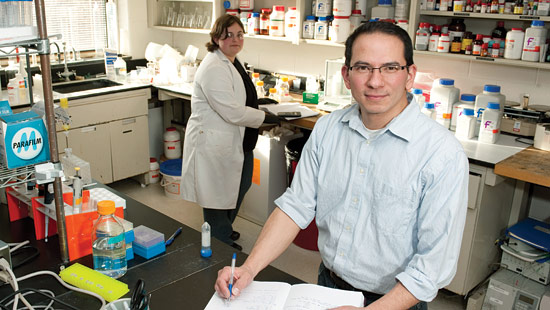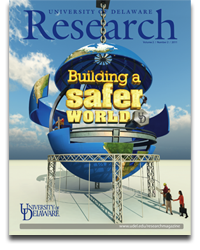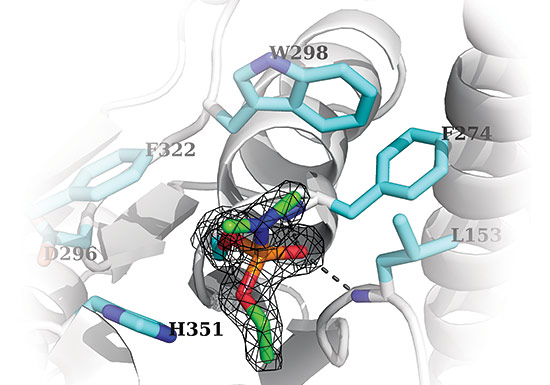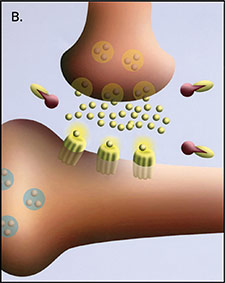The batte
at the synapse
UD and Army researchers work to detoxify nerve agents
 How do you unnerve a nerve agent? A UD-Army collaboration is making progress on two major fronts. UD chemist Brian Bahnson (left, foreground) and Army researcher Steve Kirby are identifying "bodyguard proteins" in the human body, which show potential for literally locking up a nerve agent in chemical bonds. Kirby, a civilian scientist for the U.S. Army Medical Research Institute of Chemical Defense (USAMRICD) at Aberdeen Proving Ground, Md., is working on his doctorate part-time at UD.
How do you unnerve a nerve agent? A UD-Army collaboration is making progress on two major fronts. UD chemist Brian Bahnson (left, foreground) and Army researcher Steve Kirby are identifying "bodyguard proteins" in the human body, which show potential for literally locking up a nerve agent in chemical bonds. Kirby, a civilian scientist for the U.S. Army Medical Research Institute of Chemical Defense (USAMRICD) at Aberdeen Proving Ground, Md., is working on his doctorate part-time at UD.
 In his lab near colleague Brian Bahnson's in the UD Department of Chemistry and Bio-chemistry, bio-organic chemist John Koh (right, foreground) and Linn Cadieux, a civilian scientist for the USAMRICD at Aberdeen Proving Ground, are creating 3-D computer models of potential nerve agent antidotes to explore how they function at the atomic level. (Work with actual chemical nerve agents is restricted to the Army.) Cadieux also is a part-time doctoral student at the University.
In his lab near colleague Brian Bahnson's in the UD Department of Chemistry and Bio-chemistry, bio-organic chemist John Koh (right, foreground) and Linn Cadieux, a civilian scientist for the USAMRICD at Aberdeen Proving Ground, are creating 3-D computer models of potential nerve agent antidotes to explore how they function at the atomic level. (Work with actual chemical nerve agents is restricted to the Army.) Cadieux also is a part-time doctoral student at the University.
Nerve agents such as VX and Sarin act swiftly and mercilessly. A victim can die in seconds as nerves go haywire, resulting in seizures and suffocation. The poisons are feared as weapons of warfare, and of terrorism.
The morning of March 20, 1995, members of the cult Aum Shinrikyo released Sarin in the Tokyo subway during rush hour, killing 13 and sickening more than 6,000 people. Survivors continue to experience paralysis, impaired vision, speech impediments and post-traumatic stress disorder.
In the United States, the 9/11 terrorist attacks raised new concerns about bioterrorism. In 2004, Congress passed the Project Bioshield Act, a 10-year program to acquire, for civilian use, medical countermeasures to biological, chemical, radiological and nuclear agents.
Associate Professor Brian Bahnson and Professor John Koh in the Department of Chemistry and Biochemistry at UD, are collaborating with scientists from the U.S. Army Medical Research Institute of Chemical Defense (USAMRICD) at Aberdeen Proving Ground in Maryland to find ways to combat the effects of nerve agents.
"We're the good guys," says Koh, a bioorganic chemist. "We're trying to counteract these poisons by using our knowledge of chemistry and biology to detoxify or deactivate them. These are huge Homeland Security issues."
Chemically speaking, nerve agents are organophosphates, couplings of carbon and phosphorus. They operate by inhibiting acetylcholinesterase (AChE), an enzyme in blood and tissue that regulates the neurotransmitter acetylcholine.
If a nerve agent blocks the AChE, the neurotransmitter will keep firing continuous signals across the gap between the nerve cells called the synapse — to muscles, organs and glands, sending them into hyperdrive. Among the grim effects: contracted pupils, excessive mucus, tears, saliva and sweating, vomiting, loss of bowel and bladder function, convulsions, respiratory failure, cardiac arrest and death.
Although antidotes exist, they are only moderately effective in the field. Developing a more efficient, faster-acting antidote is the aim of Koh and collaborators Doug Cerasoli, a civilian research leader at APG, and Linn Cadieux, a scientist on Cerasoli's team. Cadieux is working part-time on her doctoral degree in chemistry and biochemistry at UD, with Koh as her adviser.
Thanks to the Koh lab's emphasis on molecular modeling, computer simulations of 3-D molecules now enable the team to examine potential antidotes at the atomic level and assess how well these compounds reactivate the critical AChE enzyme.
Bahnson's goal is to find catalytic bioscavengers — chemical "bodyguards" — to protect the AChE.
"When a nerve agent hits, these protectors would attack and destroy the neurotoxin by first ensnaring it in a dead-end complex with covalent bonds and then facilitating the chemical breakdown of this complex with water — a process called hydrolysis — to free up the enzyme to do its work again," Bahnson explains.
In research funded by the Army and the National Institutes of Health, Bahnson's group already has identified two promising bioscavenger candidates — plasma platelet-activating factor acetylhydrolase (PAF-AH), which is a marker for cardiovascular diseases, and human senescence marker protein 30 (SMP30), an enzyme whose crystal structure the UD-Army team recently solved. Resembling a pinwheel, the molecule has a six-bladed beta-propeller fold and contains a single metal ion, which appears to have a catalytic role.
Further investigations are now under way to understand the relationship between the molecule's crystal structure and function, in addition to analyses of protein expression and kinetics.
Bahnson, a collaborator on Army research for the past decade, describes the partnership as one of "positive synergy."
Steve Kirby, a civilian scientist at APG, has been pursuing his doctorate as a part-time student in Bahnson's lab for the past several years.
"I certainly didn't expect to be working on nerve agents," Bahnson says. "Then Steve came to me with a proposal that expanded on our enzyme work here at UD. He became a student in my lab, and soon he will graduate with his doctorate."
"The grass-roots relationships between scientists is what it's all about," Koh adds. "We're taking a field that's been looked at for fifty years — in new directions not considered before, and exploring the unknown. It's very rewarding to be able to do fundamental research which is yielding discoveries that are important for the military and for civilians."
The 3-D model above shows how human plasma platelet-activating factor acetylhydrolase (PAF-AH) has ensnared the nerve agent Tabun. UD and Army researchers are exploring the potential of PAF-AH as an antidote to nerve agents. Graphic courtesy of Brian Bahson.
 How do you unnerve a nerve agent? A UD-Army collaboration is making progress on two major fronts. UD chemist Brian Bahnson (left, foreground) and Army researcher Steve Kirby are identifying "bodyguard proteins" in the human body, which show potential for literally locking up a nerve agent in chemical bonds. Kirby, a civilian scientist for the U.S. Army Medical Research Institute of Chemical Defense (USAMRICD) at Aberdeen Proving Ground, Md., is working on his doctorate part-time at UD.
How do you unnerve a nerve agent? A UD-Army collaboration is making progress on two major fronts. UD chemist Brian Bahnson (left, foreground) and Army researcher Steve Kirby are identifying "bodyguard proteins" in the human body, which show potential for literally locking up a nerve agent in chemical bonds. Kirby, a civilian scientist for the U.S. Army Medical Research Institute of Chemical Defense (USAMRICD) at Aberdeen Proving Ground, Md., is working on his doctorate part-time at UD.
 In his lab near colleague Brian Bahnson's in the UD Department of Chemistry and Bio-chemistry, bio-organic chemist John Koh (right, foreground) and Linn Cadieux, a civilian scientist for the USAMRICD at Aberdeen Proving Ground, are creating 3-D computer models of potential nerve agent antidotes to explore how they function at the atomic level. (Work with actual chemical nerve agents is restricted to the Army.) Cadieux also is a part-time doctoral student at the University.
In his lab near colleague Brian Bahnson's in the UD Department of Chemistry and Bio-chemistry, bio-organic chemist John Koh (right, foreground) and Linn Cadieux, a civilian scientist for the USAMRICD at Aberdeen Proving Ground, are creating 3-D computer models of potential nerve agent antidotes to explore how they function at the atomic level. (Work with actual chemical nerve agents is restricted to the Army.) Cadieux also is a part-time doctoral student at the University.











